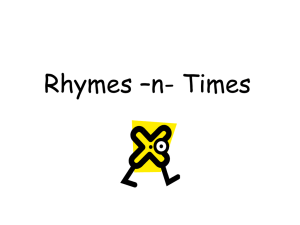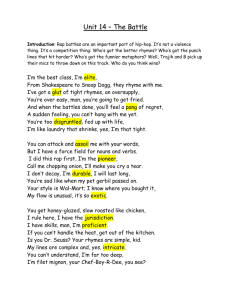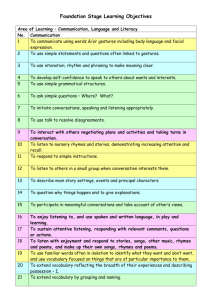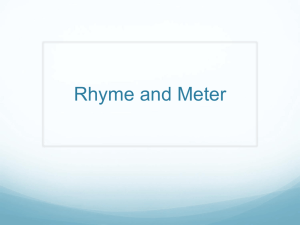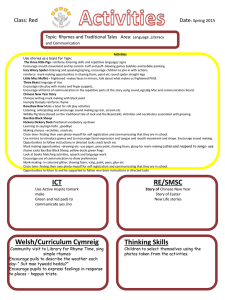Activities that encourage effective listening
advertisement
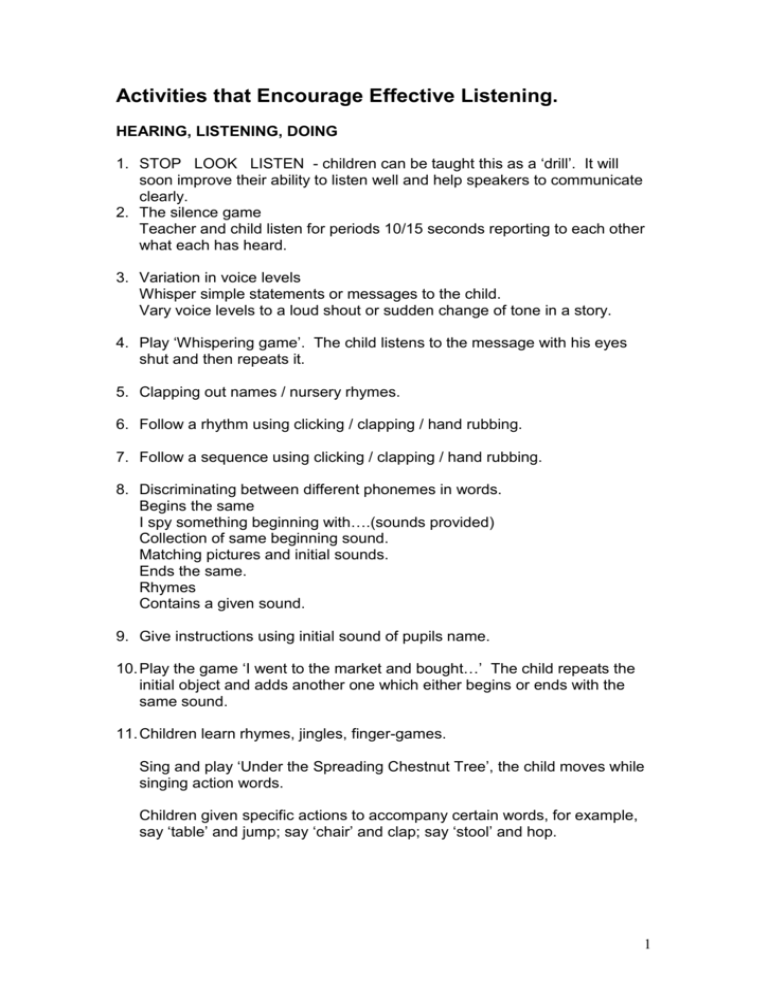
Activities that Encourage Effective Listening. HEARING, LISTENING, DOING 1. STOP LOOK LISTEN - children can be taught this as a ‘drill’. It will soon improve their ability to listen well and help speakers to communicate clearly. 2. The silence game Teacher and child listen for periods 10/15 seconds reporting to each other what each has heard. 3. Variation in voice levels Whisper simple statements or messages to the child. Vary voice levels to a loud shout or sudden change of tone in a story. 4. Play ‘Whispering game’. The child listens to the message with his eyes shut and then repeats it. 5. Clapping out names / nursery rhymes. 6. Follow a rhythm using clicking / clapping / hand rubbing. 7. Follow a sequence using clicking / clapping / hand rubbing. 8. Discriminating between different phonemes in words. Begins the same I spy something beginning with….(sounds provided) Collection of same beginning sound. Matching pictures and initial sounds. Ends the same. Rhymes Contains a given sound. 9. Give instructions using initial sound of pupils name. 10. Play the game ‘I went to the market and bought…’ The child repeats the initial object and adds another one which either begins or ends with the same sound. 11. Children learn rhymes, jingles, finger-games. Sing and play ‘Under the Spreading Chestnut Tree’, the child moves while singing action words. Children given specific actions to accompany certain words, for example, say ‘table’ and jump; say ‘chair’ and clap; say ‘stool’ and hop. 1 12. Rhyming Activities. Encourage child to say what he/she is doing in rhyme: e.g. 1. “I’m bouncing a ball on the wall”. “Mike’s on his bike.” “I’m jumping up and down like a clown” . “Jade’s in the shade.” “I’m putting my hand in the sand”. “Ann can see a man.” 2. Make up silly rhymes. 3. Can you be? Can you draw? Can you say? RHYME ALLTERATION A frog on a log? A hat on a head? A king on a swing? A fat fox on a fence? A man in a van? A big bear in a box? A bug on a slug? A cheeping chick? The tail of a whale? A shivering sheep? A cat on a mat? A sizzling sausage? A lion with an iron? A pink pig paddling? A Ted in a bed? A roaring rhinoceros? A Dad who is mad? A hungry hamster? 4,. Rhyming Objects Have a table for objects that rhyme. Ask the children to select a pair of objects and help them make up a rhyme for them. 2 AUDITORY DISCRIMINATION 1. Odd word out game for listening Adult says ‘Listen to these words. Which one sounds different?’ hat fat cat banana mat fan man mix can pan red bed boy fed led pet pig jet set hill pill toy fill mill Jill spill apple bill cap tap sock clap ring bell sing spring rub hat tub look book top took 2. Listen carefully ‘I want you to listen for a number (animal, car, child’s name, colour, etc.pick one of these). When you hear it touch my arm. tree me three free pen ten pen when shoe chew two who late eight date hate live dive hive five sticks six tricks licks run one bun fun more chore four war log fog cog dog pig fig dig wig how now cow bow sheep sleep deep keep take make cake snake course sauce horse force Sam ham cam lamb scowl growl prowl owl.’ (The words in each group need not rhyme with each other.) 3. ‘I’m going to say lots of words. Listen carefully and each time I say a food word say the word loudly after me. At the end we’ll count out how many food words there were’. Box, carpet, stairs, eggs, car, bag, potatoes, etc. LISTENING GAMES 1. Silly stories Say ‘I’m going to tell you a silly story. Every time you hear something silly put up your hand’. Sample silly story: Once there was a man whose house was at the bottom of the sea. Every morning he would dive downstairs to have a nice cup of seaweed for his breakfast. Afterwards he would clean his teeth in the same and then swim upstairs to put his clothes on, etc. etc. 3 2. Silly endings Take turns to complete sentences with a silly ending. Starters: 1. As I walked down to the shops I saw… 2. My teacher told me to… 3. Riddles A person who cures sick people is a … A person who helps children learn is a… An animal with four legs and barks is a… I swim in a pond and go quack, I am a … I lock the door, I’m a… 4. Use riddle and rhymes Have children make up simple riddles and rhymes, i.e. an animal that rhymes with log; a thing you read which rhymes with look; a flower which rhymes with hose; a building you live in which rhyme with mouse; an animal that rhymes with mat; a part of the body which rhymes with land. 5. Riddles e.g. I write on a blackboard. What am I? (chalk) Rhyming riddles e.g. I’m black and fat. And Purr on the mat. What am I? (cat) AUDITORY MEMORY 1. Ask child to memorise a list, e.g. ‘I am going to put on my brown shoes… and my white socks…and my blue scarf…’ At the end each child has to Remember how she is supposed to be dressed. Variations of this could be: ‘I went to the park and saw a… and a…’ My House: ‘In my house there are…and …and …’ My School: ‘In my school there are…and …’ 2. Instructions Give a range of instructions beginning with on sequence requests, i.e. ‘Bring your book please’ through to several sequence requests like ‘Go to the top drawer and give me your blue socks’. Child requests an adult to do similar things. 4 3. Memory game. I went to the market and bought:Nursery Rhymes, address, Days of week. 4. The child is given messages to take round school; simple one to begin with then increasing in length and complexity of language according to the child’s age and ability. 5. Recalling rhymes. 6. Recalling stories or details from stories. 7. Repeating rhythm patterns. 8. Repeating number or letters. 9. Repeating oral sentences of increasing complexity. 10. Repeating nonsense words. 11. Following verbal instructions – gradual increase in number and difficulty. Instruction chains – passing words and sentences to other children. 12.have a ‘silly’ puppet or mascot that can’t remember words. Make deliberate mistakes yourself and see if the children can spot them. 13. Read lots of poems and repetitive and patterned stories to the children – e.g. ‘The Gingerbread Men’. ‘The Billy Goats Gruff’. Get the children to join in. Miss out words in other stories and let the children fill in for you. SOUND GAMES 1. Paired sounds: A tape recorder can be used. Say ‘I’m going to play two sounds. Listen carefully (play sounds). What do you think each sound was?’ Examples: motor bike; train; car; bus; car door; classroom door; class members’ voices; musical instruments. 2. Everyday sound using cassette recorder. The children identify the sounds by name. Children listen to sounds, identify them and associate sound with pictures. Children listen to a category of sounds, for example, all traffic or all bells; and pick out one particular sound: e.g. ambulance siren or bicycle bell. 3. Chime bars: identifying high pitch, middle pitch and low pitch while the child: a) watches the chime bars b) faces away A representative chant or story, (Father bear, Mother bear and baby bear), can be helpful. 5 4. Ask child to respond when he hears a specific sound embedded in a background noise, for example, pick out a dog barking from animal noises. 5. Games: ‘I hear with my little ear’ beginning with a specific letter-sound. 6. Call out groups of words with same ending except for one: e.g. mop, hop, pop, rod. 7. Child identifies a boy or girl’s name from a list of words: e.g. loan, moan, Joan etc. 8. a) Child is blindfolded and asked to say which is ‘John’s voice’ from two boys speaking separately. Then progressing to finding Sally’s voice from three girls speaking separately. The number of voices can be increased when needed. b) One child is blindfolded. The teacher asks a child in the group to sing or speak and the first child must recognise the voice. 9. Locate where a sound came from? Play games where each child takes it in turns to be blindfolded and has to point to the source of a sound. Vary the degree of challenge by making the sounds near to the child, in front of, behind, left and right. Vary the distance. 10.Identify the sounds correctly? Use different sound makers, e.g. a comb and paper, shutting door, crumpling of paper, a spoon in a cup. Make sure that all children with the sounds made by these objects. One child turn around, sound is made with one of the above, child has to identify which one it was. 11.Play musical games. Walk when you hear the drum. Sit when you hear the triangle. Run when you hear the tambourine. 12.Make a set of shakers in which there are two of each sound. Mix shakers up. Ask children to find pairs of the same sound. 13.Lstening to stories and have to react, i.e. clap, stand up etc, when they hear certain words. 14.Ask children to listen for things that sound strange in tongue twisters. Say a known tongue twister deliberately substituting a sound. Peter Piper liked a peck of tickled pepper. 15 Sequence sounds Start with activities involving sequencing such as dressing up in clothes in the order given, using pictures of events in a story, get the child to 6 sequence them correctly, say a sentence with words in random order and get the child to correct the order, break words up into syllables. 16.Musical activities and action songs are good for sequencing, rhyme, alliteration and physical development. Games to develop the notion of turn taking Rolling a ball to and fro. Building a tower of bricks. Placing pegs in pegboard Posting shapes Draw a man Passing an object – you can talk when you are holding it. Passing an object – describe it with an adjective/adverb/colour/etc. Oral Sentence games – see Developing Early Writing. 7


